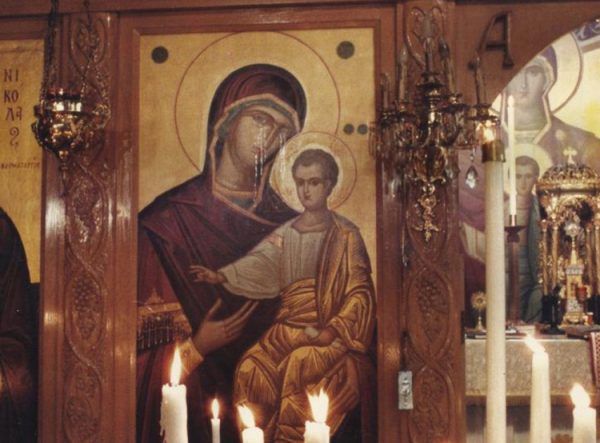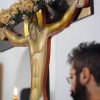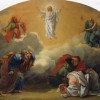That would have been my reaction when I was a Protestant long ago, even when I was an Anglo-Catholic Episcopalian. We didn’t disbelieve in miracles. We knew there were miracles in New Testament times and afterwards. Roman Catholics claimed to have them. But this just wasn’t part of our experience. Not us. Not here. Not now. ![]()
And then I saw one. I think it was in the spring of 1987 that an Orthodox priest friend invited me to an OCA clergy conference in Chicago. I was still Episcopalian, but more than curious about Orthodoxy. One afternoon someone said casually, “Let’s go over and visit the weeping icon”, so we did. This is it. I had never seen anything like it. This was something beyond my previous imaginings. It didn’t fit into any of my categories. I even peeked behind the iconostasis to see if… but no, there were no hoses attached.
These things obviously had been covered in the press. I just never noticed. Here’s a New York Times article about this one.
The icon stopped weeping after a time. Then, I have been told, she resumed briefly, and I heard that the parish priest was distraught. He thought he just couldn’t handle all the commotion a second time. So she ceased again.
The Presence of the Theotokos
Among Roman Catholics the Mother of God usually appears in visions with associated miracles. Don’t discount this. I know people who have been genuinely moved to the Good by these.
Likewise, in the Orthodox Church she sometimes appears in dreams and visions. A former member of our parish told that his Greek grandmother when she was a little girl woke up one night to see a woman in light standing at the foot of her bed. Terrified, she ran to her mother who said, “Oh, don’t worry. That’s just the Panaghia. * She won’t hurt you. Go back to sleep.”
light standing at the foot of her bed. Terrified, she ran to her mother who said, “Oh, don’t worry. That’s just the Panaghia. * She won’t hurt you. Go back to sleep.”
- The popular Greek name for Mary, taken from the ascription at the end of litanies: “Calling to remembrance our all-holy [pan aghia], immaculate, most blessed and glorious Lady the Theotokos and ever-virgin Mary, with all the saints…”
I think this suggests how thoroughly and naturally (to put it mildly!) the Theotokos is integrated with the life of Orthodox people. Not that she shows up every 10 minutes, but her involvement with us is not considered all that remarkable. This seems to be especially true in the “old Orthodox countries”. Why? And why do Protestants and even Anglo-Catholics seem not to have these experiences with her?
However, with us Orthodox her usual way of making her presence known is through her weeping icons. She gives us something we can get our hands on. Literally.
It’s called myrrh. It flows from her eyes and usually exudes a sweet fragrance. What is this myrrh? It’s a mystery! No one knows. Obviously it has a chemical makeup or it wouldn’t exist in our world, but it isn’t in the nature of Orthodox people to take it to a chem lab and test it. Even if we knew what it was, what difference would that make? How would that diminish the miracle? How would that explain why it flows only from icons? sometimes even from paper icons? and on icons of the Theotokos, only from her eyes?
But before we talk about weeping icons of the Theotokos, let’s look at another much less common category of miraculous images called…
Myrrh-streaming Icons
With these icons, the myrrh streams from the entire surface of the image.
I think these are usually of Saint Nicholas. In Blog Post 65, you can read about one at Saint George Church, Michigan City, Indiana. I know of another at Saint Nicholas Church, Tarpon Springs, Florida.
But there is presently a very unusual one of Saint John the Baptist at Assumption Greek Orthodox Church in Homer Glen, Illinois, a south Chicago suburb. Here’s some Chicago TV coverage of it:
And an article from the Tribune.
While I was sick, some of the myrrh was brought to me on a little ball of cotton. The spicy sweet fragrance lasted for about a year. Did it help? Unless there is instant cure, how can we know? All I know is that with the myrrh and a good neurologist, I’m better now. The certain result is that I have come close to John, who had previously seemed distant to me.
Weeping Icons of the Theotokos
These are the usual kind, in which the myrrh flows from her eyes. “Usual”? Well, they’re certainly not rare. Google it and see for yourself.
If you do, don’t confuse them with a current “experimental noise punk” band named “Weeping Icon”. (Don’t ask…) They advertise, I think inadvertently, “unlimited streaming” (!) of their music. It’s a weird world we live in.
Weeping icons of Mary are found all over. Here’s one in Hawaii. There are even icons of the Theotokos that are carried from church to church, and she weeps wherever she goes.
A friend told me about one years ago at Saint Vladimir’s seminary in New York, seen by about a half dozen people one Sunday afternoon. He had returned from his Sunday parish work, walked into the Saint Vlad’s chapel, and saw a puddle on the floor. He wiped it up, then returned and there it was again. Then he looked and saw that it was coming from an icon of the Theotokos. He called some friends and a professor or 2, 1 of whom wouldn’t come because he didn’t believe it. She continued to cry for a little while, then stopped. No explanation.
In 1988 simple paper icons wept at the Greek Orthodox Camp Nazareth outside Pittsburgh. Many people saw this, including a number from the Pittsburgh press. People said the fragrance was so strong they could smell it as they drove into the camp. Here is a television account:
For many years there was a weeping icon in a home in Milwaukee. It belonged to an old lady who had bought this simple icon of the Theotokos from a poor woman in Greece as an act of charity. Her daughter told me that when her mother prayed with it, the myrrh just poured down from it, so they kept having to wipe it up off the table. They told only a few people about it, not wanting to cause a commotion. The old lady has gone now to be with Jesus and his Mother now. I don’t know if the icon still weeps.
Here is the second weeping icon I saw:
The Miraculous Weeping Icon of Our Lady of Cicero
This was the title given by His Eminence Metropolitan Philip (of blessed memory) to the Weeping Icon at Saint George Antiochian Orthodox Church in Cicero, Illinois, a west Chicago suburb.
It was on the eve of Lazarus Saturday in 1994 that a priest, a fairly new convert to Orthodoxy assisting at the service, noticed something shiny on the icon of the Theotokos on the iconostasis. Being new, he thought maybe this was some strange anointing he hadn’t yet heard of, so he asked the pastor Father Nicholas Dahtal, who went over to the icon, saw the tears running down profusely from her eyes and fell to his knees. A layman came over with a big jar which he had brought from his front hall at home (after he left home he asked himself, “Why did I bring that along?”) and they used it to collect the myrrh.
Father Nick called Metropolitan Philip who sent His Grace Bishop Basil to check this out. The first thing he did was wipe off the myrrh and exorcise the icon, in case this was some kind of demonic manifestation. (The devil can also can do signs and wonders.) Bishop Basil went out for a cup of coffee, came back in, and she was still weeping. He also fell down prostrate before her. The title “Our Lady of Cicero” sounded odd to me at first; I was accustomed to more venerable old world titles, Our Lady of Kazan and the like. But God is in America, too. The Theotokos can also make her presence known in Cicero, Illinois. And there were miracles.
I went down to Cicero several times. For the first few months the church daily was filled with pilgrims, buses parked outside, often police directing traffic. Inside the church was a multitude of flowers and burning candles, and a great crowd standing in line. It seemed like what I had read about medieval pilgrimage sites. I was still new to the Orthodox Church, and in time I learned that Orthodoxy today has many place like this.
I helped anoint people of all sorts: Orthodox, Roman Catholics, Protestants, rich and poor, male and female, the Dean of the Roman Catholic cathedral in Joliet. After I was exhausted and gave it over to someone else, the long line of pilgrims continued.
There are some strange stories: Father Nick had a professional photographer come in to take pictures of the icon, late at night so there wouldn’t be people in the way and so he could get good lighting. The photographer said, “I see it, but I don’t believe in this kind of stuff”. He took many photos. When he came back and showed  Father Nick the photographs, none showed the tears. He said, “I don’t know what I think now, but there’s something I can’t explain going on here”. Father Nick said, “Okay, now you believe a little bit. Go take another picture”. So he took 1 more picture. This is it. See for yourself.
Father Nick the photographs, none showed the tears. He said, “I don’t know what I think now, but there’s something I can’t explain going on here”. Father Nick said, “Okay, now you believe a little bit. Go take another picture”. So he took 1 more picture. This is it. See for yourself.
They also had trouble with the church bells. Now and then they would start ringing, and they couldn’t get them to stop.
Father Nick’s young son came to church with his dad one day and brought along some cartoon videos to watch. They wouldn’t play on the church VCR – blank screen. (You young people, ask your grandparents what VCRs were.) Then they tried Orthodox Church videos, and they played – no problem. Then they tried the cartoon videos elsewhere – no problem. Finally by process of elimination, they figured out that when the icon was weeping, only religious videos would play on the church VCR!
A family from Saint George had a paper picture of Our Lady of Cicero which began to weep profusely and continued for some time.
There was later a great fire at Saint George Church, caused by an electrical short. Much of the church interior was destroyed. The icon screen and the icons on it were gone or melted out of shape, with once exception: the Weeping Icon of Our Lady of Cicero which came through completely untouched.
The icon continued to weep off and on or some time, then stopped.
In the 24 years since the miraculous icon began to weep, well over a million people have visited Saint George’s Church. More than 100,000 cotton swabs were distributed in the 2 months after the miracle was witnessed. More than 1,000 churches received bottles of oil mixed with the tears that are used in healing services all over the United States. We at Saint Nicholas anoint people with this myrrh frequently in times of need. It’s now greatly diluted with olive oil, but there are bound to be some molecules left.
What ever are we to make of all this?
Why do icons of the Theotokos weep? Is it a sign of oncoming troubles? There were many weeping and other miraculous icons in Russia after the Communist revolution. But weeping isn’t necessarily out of sorrow. There are also tears of joy and tears of love. The effect at Saint George, Cicero was to revive a weary priest and struggling parish.
Someone asked me years ago why Chicago gets all the weeping icons. I thought, “How should I know?”. Before I could stop myself I heard my mouth blurt out, “Because of the Cubs?” * That was flippant. I definitely should not have said that. But really, how in the world would I know why icons weep? No one knows except the Theotokos, and she’s not telling.
- That was while the Cubs had long been a losing team. No more.
All I know is what the weeping icons have done for me:
After seeing the icon at Saint Nicholas, Chicago, I saw that in this very traditional, seemingly stodgy old Orthodox Church there are wonderful things happening. I went home and began to talk publicly about Orthodoxy in my Episcopalian parish, which in time caused me to be kicked out of the Episcopal Church, and then there was nothing to do but try to start an Orthodox mission, and so we  did, and here we are 31 years later – Saint Nicholas Orthodox Church, Cedarburg, Wisconsin. Only later did I realize that the weeping icon was at Saint NicholasChurch, Chicago – 1 of our many Saint Nicholas connections.
did, and here we are 31 years later – Saint Nicholas Orthodox Church, Cedarburg, Wisconsin. Only later did I realize that the weeping icon was at Saint NicholasChurch, Chicago – 1 of our many Saint Nicholas connections.
The icon at Saint George, Cicero, affected me like this: She confirmed to me that God is real, that Christ and his Mother are here with us. Now, when I’m tempted to doubt – I don’t know about you, but I am weak; I doubt – then I think back to what I saw with my own eyes and felt for myself, the miraculous  fragrant oil that I had to wipe off my hands, this undeniable material miraculous manifestation of the other World into this world. I cannot doubt that. It made me feel, I think, like the disciples on Pascha night, who “disbelieved for joy” – it seemed too good to be true, but it was! And I say to myself, “Yes, I saw the weeping icon. It’s true!” And my doubt goes away.
fragrant oil that I had to wipe off my hands, this undeniable material miraculous manifestation of the other World into this world. I cannot doubt that. It made me feel, I think, like the disciples on Pascha night, who “disbelieved for joy” – it seemed too good to be true, but it was! And I say to myself, “Yes, I saw the weeping icon. It’s true!” And my doubt goes away.
Are there any dangers here? Yes. People can become spiritual “thrill-seekers”, chasing from miracle to miracle, like those who are forever trying to recreate the feelings of their conversion experiences or whatever. Beware! If it’s a choice between visiting a weeping icon or caring for “least of these my brethren”, you know which one to choose. But that’s not really the choice, is it? And as I looked into the faces of the people I anointed at Saint George’s I felt they were seeking – “Lord, I believe; help my unbelief” – just as I had been.
I think because we are flesh and blood, not just spirit, we need occasional material signs of the reality of God and his saints. And all over the world, certainly in the Orthodox world, for 20 centuries he has given us these signs. Ever since the risen Christ appeared bodily to the apostles, was touched by them, ate and drank with them, fixed breakfast for them, he has given his people solid cause for faith, material signs of the ineffable, incomprehensible, invisible Mystery that always surrounds us.
Brothers and sisters, if ever you can go and visit a weeping icon, go!
What follows is the Slavonic version of Saint Nektarios’ hymn to the Theotokos. For the background and the text, go here.

















